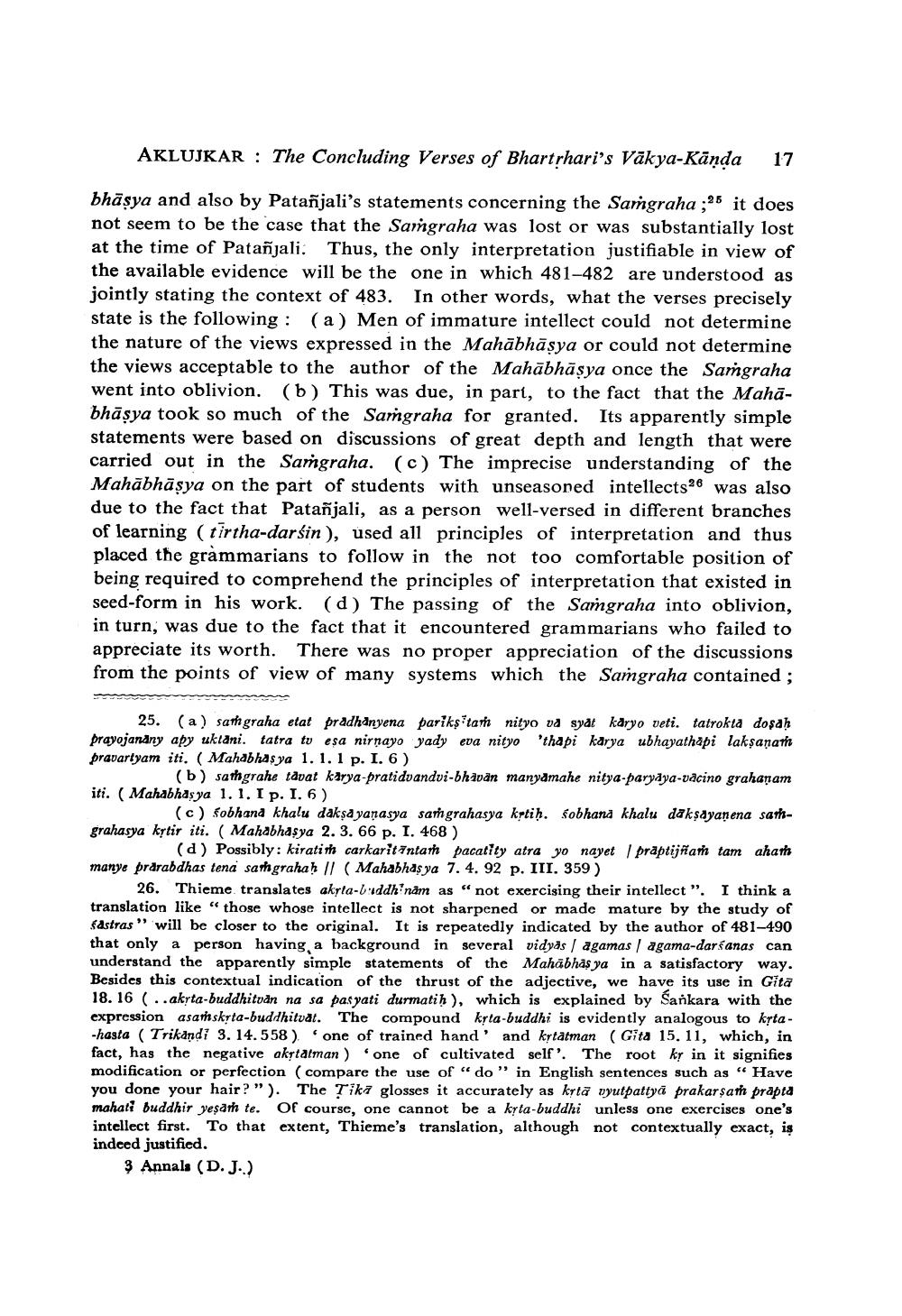Book Title: Concluding Verses Of Bhartrharis Vakya Kanda Author(s): Ashok Aklujkar Publisher: Ashok Aklujkar View full book textPage 9
________________ AKLUJKAR : The Concluding Verses of Bhartrhari's Vākya-Kānda 17 bhäsya and also by Patanjali's statements concerning the Sangraha ;25 it does not seem to be the case that the Sangraha was lost or was substantially lost at the time of Patañjali. Thus, the only interpretation justifiable in view of the available evidence will be the one in which 481-482 are understood as jointly stating the context of 483. In other words, what the verses precisely state is the following: (a) Men of immature intellect could not determine the nature of the views expressed in the Mahābhāsya or could not determine the views acceptable to the author of the Mahābhāsya once the Saṁgraha went into oblivion. (b) This was due, in part, to the fact that the Mahabhāşya took so much of the Sangraha for granted. Its apparently simple statements were based on discussions of great depth and length that were carried out in the Saṁgraha. (c) The imprecise understanding of the Mahābhāsya on the part of students with unseasoned intellects 26 was also due to the fact that Patañjali, as a person well-versed in different branches of learning (tirtha-darsin), used all principles of interpretation and thus placed tħe grammarians to follow in the not too comfortable position of being required to comprehend the principles of interpretation that existed in seed-form in his work. (d) The passing of the Samgraha into oblivion, in turn, was due to the fact that it encountered grammarians who failed to appreciate its worth. There was no proper appreciation of the discussions from the points of view of many systems which the Samgraha contained ; 25. (a) sath graha etat pradhanyena pariks tam nityo va syat karyo veti. tatrokta dosah prayojandny apy uklani. tatra tv esa nirnayo yady eva nityo 'thapi karya ubhayathapi laksanath pravartyam iti. (Mahabhasya 1.1.1 p. I. 6) (b) sangrahe tavat karya-pratidvandvi-bhavan manyamahe nitya-paryāya-vacino grahanam iti. ( Mahabhasya 1. 1. I p. I. 6) (c) sobhana khalu dakșa yanasya saṁgrahasya krtih. Sobhana khalu dakşayanena sathgrahasya kytir iti. (Mahabhasya 2. 3. 66 p. I. 468 ) (d) Possibly: kiratimh carkaritintam pacatity atrayo nayet I praptijñam tam ahath manye prarabdhas tena sathgrahah II ( Mahabhas ya 7. 4. 92 p. III. 359) 26. Thieme. translates akyla-luddh nam as “not exercising their intellect". I think a translation like those whose intellect is not sharpened or made mature by the study of fastras" will be closer to the original. It is repeatedly indicated by the author of 481-490 that only a person having a background in several vidyds / agamas / agama-darśanas can understand the apparently simple statements of the Mahābhas ya in a satisfactory way. Besides this contextual indication of the thrust of the adjective, we have its use in Gita 18. 16 ( .. akrta-buddhitvan na sa pasyati durmatih ), which is explained by Sankara with the expression asanskrta-buddhitvat. The compound krta-buddhi is evidently analogous to kyta - -hasta ( Trikandi 3. 14.558) one of trained hand' and kytatman (Gita 15.11, which, in fact, has the negative akrtatman) one of cultivated self'. The root kr in it signifies modification or perfection (compare the use of “do" in English sentences such as " Have you done your hair?"). The Tika glosses it accurately as krta vyutpattyā prakarsam prapta mahati buddhir yesar te. Of course, one cannot be a kyta-buddhi unless one exercises one's intellect first. To that extent, Thieme's translation, although not contextually exact, is indeed justified. 3 Annals (D. J.)Page Navigation
1 ... 7 8 9 10 11 12 13 14 15 16 17 18
